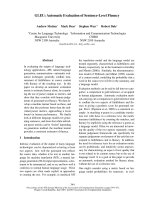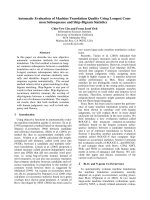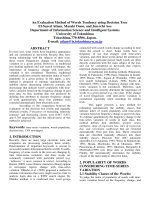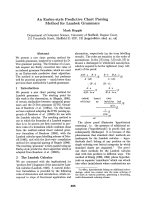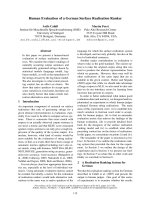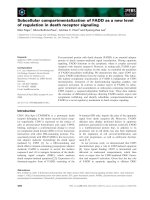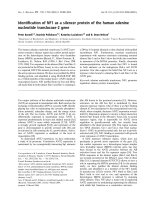Báo cáo khoa học: "An evaluation of decapitation as a method for selecting clonal Quercus petraea (Matt) Liebl with different branching intensities" ppt
Bạn đang xem bản rút gọn của tài liệu. Xem và tải ngay bản đầy đủ của tài liệu tại đây (866.24 KB, 14 trang )
Original
article
An
evaluation
of
decapitation
as
a
method
for
selecting
clonal
Quercus
petraea
(Matt)
Liebl
with
different
branching
intensities
R
Harmer,
C
Baker
Forestry
Commission
Research
Station,
Alice
Holt
Lodge,
Wrecclesham,
Farnham,
Surrey,
GU10 4LH,
UK
(Received
25
January
1993;
accepted
2
September
1994)
Summary —
The
effect
of
decapitation
on
branch
production
in
5
clones
of
oak
was
observed
over
the
2
flushes
of
growth
occurring
during
1
season.
Concurrent
experiments
were
carried
out
under
natu-
ral
conditions
in
the
nursery
and
2
different
temperature
regimes
in
growth
chambers.
Decapitation
had
no
effect
on
the
number
of
buds
becoming
active
but
usually
increased
both
the
proportion
of
active
buds
forming
branches
and
the
number
of
branches
produced
during
each
flush.
More
branches
were
formed
during
the
first
flush
of
growth
but
the
largest
effect
of
decapitation
occurred
during
the
second
flush.
There
were
significant
differences
between
clones
but
the
clonal
order
of
branchiness
varied
between
flushes
and
treatment.
Lower
temperatures
reduced
the
rate
of
shoot
development
but
had
only
small
effects
on
the
length
of
new
leading
shoot
and
the
proportion
of
buds
becoming
branches.
The
significance
of
these
results
for
the
selection
of
oaks
with
different
branching
patterns
is
dis-
cussed.
Quercus
petraea / clone
/
bud
/
branching
Résumé —
Une
évaluation
de
la
décapitation
comme
méthode
de
sélection
clonale
de
Quer-
cus petraea (Matt)
Liebl
présentant
différentes intensités
de
branchaison.
Les
effets
produits
par
la
décapitation
sur
la
ramification
observée
sur
5
clones
de
chêne
ont
été
étudiés
au
cours
des
2
vagues
de
croissance
se
produisant
en
une
saison.
Des
expériences
sont
effectuées
simultanément
en
pépinière,
dans
des
conditions
naturelles,
et
en
laboratoire,
en
ayant
recours
à
2
régimes
de
tempéra-
tures
différents.
La
décapitation
n’affecte
en
rien
le
nombre
des
bourgeons
devenant
actifs
(tableau
III),
alors
qu’elle
augmente
généralement
à
la
fois
la
proportion
de
bourgeons
actifs
formant
des
branches
et
le
nombre
de
branches
produites
pendant
chaque
vague
de
croissance
(fig
4).
Bien
que
la
ramifica-
tion
soit
plus
fréquente
sur
le
dernier
cycle
de
l’année
précédente
que
sur
le
premier
cycle
de
l’année
en
cours,
la
décapitation
a
une
plus
grande
influence
sur
la
ramification
dans
le
second
cas
que
dans
le
premier
(figs
5
et
6).
Des
variations
significatives
apparaissent
d’un
clone
à
l’autre,
mais
aussi selon
le
cycle
de
croissance
considéré
et selon
les
traitements
(tableau
IV).
Il
s’avère
que
les
températures
plus
basses
réduisent
la
vitesse
de
développement
de
la
pousse,
mais
n’ont
que
peu
d’effet
sur
la
longueur
de
la
nouvelle
pousse
apicale
et
la
proportion
de
bourgeons
donnant
naissance
à
des
branches
(figs
2
et
3).
La
portée
qu’ont
ces
résultats
sur
la
sélection
des
chênes
présentant
des
systèmes
de
ramifica-
tion
différents
fait
l’objet
de
discussions.
Quercus
petraea
/ chêne / clone / bourgeon
/ ramification
INTRODUCTION
Deciduous
oaks
are
some
of
the
most
important
hardwood
timber
trees
in
north-
temperate
Europe
and,
for
example,
in
Great
Britain
they
form
30%
of
broadleaved
high
forest
providing
25-30%
of
hardwood
timber
for
sawmills
(Evans,
1984).
However,
the
quality
of
oak
timber
is
very
variable
and
there
may
be
a
10-fold
difference
in
the
value
of
high-
and
low-grade
timber
(White-
man
et al,
1991).
Despite
the
commercial
importance
of
oak
there
has
been
little
emphasis
on
improvement
of
planting
stock
by
the
selection
of
superior
genotypes
and
large
scale
trans-European
provenance
trials
with
Quercus
robur
L and
Q
petraea
(Matt)
Liebl
are
only
just
beginning.
These
will
not
yield
final
results
for
several
decades
and
the
uncertainty
of
seed
supply
may,
even
then,
prevent
use
of
the
best
provenances.
Several
studies
have
shown
that
it
is
pos-
sible
to
produce
clonal
oaks
either
by
micro-
propagation
of
softwood
cuttings
(Klein-
schmit
et al,
1975a;
Spethmann,
1986;
Meier-Dinkel,
1987;
San-Jose
et al,
1990).
Such
procedures
could
be
used
to
supply
suitable
planting
stock
and
avoid
the
vagaries
of
seed
supply.
At
present
these
methods
are
only
successful
with
some
juve-
nile
material
but
there
is
no
current
method
for
determining
whether
the
juvenile
clones
capable
of
mass
propagation
will
produce
high
quality
trees.
The
UK
Forestry
Com-
mission’s
oak
improvement
programme
is
investigating
methods
of
identifying
supe-
rior
trees
when
they
are
juvenile
and
can
be
used
for
clonal
propagation.
The
quality
of
oaks
for
saw
logs
is
related
to
the
size
and
number
of
branches
on
the
trunk;
large
branches,
or
large
numbers
of
branches
will
significantly
reduce
the
qual-
ity
and
hence
value
of
oak
timber.
Careful
silvicultural
practice
can
be used
to
manip-
ulate
branching
but
the
normal
tendency
of
oak
to
produce
a
spreading
crown
with
large
branches
is
difficult
to
suppress
whilst
main-
taining
an
acceptable
combination
of
height
and
diameter
growth.
An
important
part
of
our
oak
improvement
programme
aims
to
gain
a
better
understanding
of
the
develop-
ment
and
control
of
branching
and
identify
genotypes
with
superior
stem
and
crown
form.
Studies
with
obeche
(Triplochifon
scle-
roxylon,
K
Schum),
a
fast
growing
tropical
tree,
have
shown
that
it
is
possible
to
relate
branching
in
small,
young,
clonal
plants
to
that
of
larger
plants
growing
in
the
field.
When
small
plants
were
decapitated,
the
number
of
branches
produced
varied
between
clones
(Leakey
and
Longman,
1986);
clonal
field
trials
showed
that
after
5
years’
growth
the
number
of
branches
on
the
main
stem
was
positively
correlated
with
branch
production
in
decapitation
experiments
(Leakey
and
Ladipo,
1987).
The
following
experiments
were
carried
out
in
order
to
evaluate
the
use
of
decapitation
as
a
method
for
selecting
oaks
with
differ-
ent
branching
patterns.
Growth
in
oak
is
determinate
and
there
are
1
or
more
dis-
crete
periods
of
shoot
extension
during
the
growing
season
which
are,
in
part,
under
endogenous
control
(Barnola
et al,
1986;
Alatou
et al,
1989;
Barnola
et al,
1990;
Par-
mentier
et al,
1991;
Barnola
et al,
1993).
As
the
formation
of
lateral
branches
appears
to
differ
between
periods
of
growth
occurring
at
different
times
of
the
year
(Harmer,
1992b),
experiments
were
car-
ried
out
using
overwintered
shoots
and
those
produced
during
the
first
period
of
growth
in
spring.
METHODS
Plant
culture
and
experimental
treatments
During
summer
1989
leafy
cuttings
were
taken
from
shoots
growing
on
stumps
of
10-year-old
Q
petraea
trees
felled
during
winter
1988.
Cuttings
were
rooted
using
methods
described
by
Harmer
and
Baker
(1991).
Surviving
cuttings
were
over-
wintered
in
the
trays
of
substrate
used
for
rooting
and
then
grown
outdoors
for
1
season
in
10
cm
plastic
pots
containing
3:1
peat/grit
compost
with
slow
release
fertiliser
(18:11:10,
N:P
2O5
:K
2
O,
4.3
kg
m
-3).
In
February
1991,
similar
sized
plants
from
5
clones
from
parents
with
apparently
different
growth
form
were
repotted
into
12.5
cm
diameter
plastic
pots
of
compost.
The
plants
selected
had
produced
2
flushes
of
growth
in
1990
and
had
a
live
terminal
bud.
Most
plants
had
produced
1-2
branches
which
were
removed
after
repot-
ting.
Plants
were
then
randomly
assigned
to
2
decapitation
treatments
in
3
environmental
con-
ditions;
there
were
5-10
plants
of
each
clone
receiving
the
decapitation
treatments
in
each
environment.
i.
Decapitation
—
the
terminal
bud
was
removed,
using
forceps,
from
half
of
the
plants
at
the
start
of
both
the
first
and
second
flushes
of
growth;
the
remaining
plants
were
untreated,
intact,
controls.
ii.
Environment
—
equivalent
numbers
of
each
clone
receiving
the
2
decapitation
treatments
were
grown
in
growth
chambers
under
2
different
temperature
regimes:
warm,
20°/15°
day/night;
cool,
15°/10°
day/night.
Plants
were
also
grown
under
natural
conditions
in
the
nursery.
Environmental
differences
between
chambers
were
minimised:
day
length
was
18
h
and
sup-
plied
by
both
fluorescent
tubes
(Sylvania,
Cool
white)
and
tungsten
lamps;
photosynthetically
active
radiation
at
canopy
height
was
adjusted
weekly
to
145
μmol
m
-2
s-
1;
day/night
water
vapour
pressure
deficits
were
approximately
2.3/1.0
mb,
respectively.
Pots
were
watered
as
required
and
given
liquid
fertiliser
(N:P
2O5
:K
2
O,
8:4:4)
at
14-d
intervals.
During
the
first
6
weeks
of
the
experiment,
leaves
on
some
plants
in
the
warm
environment
developed
mildew;
these
leaves
were
removed
immediately.
No
mildew
developed
on
plants
in
the
cool
chamber.
The
few
aphids
that
appeared
were
controlled
by
hand
during
experimental
observations.
Plants
in
the
nursery
were
sprayed
with
pyrethrum-based
insec-
ticide
and
sulphur
to
control
aphids
and
mildew,
respectively.
Assessment
The
plants
in
the
growth
chambers
were
observed
on
alternate
days
throughout
the
experiment,
which
lasted
for
2
periods
of
shoot
growth.
Three
sections
of
leading
shoot
were
observed
during
the
experiment
(fig
1):
a)
original shoot
—
the
terminal
section
of
shoot
produced
by
the
sec-
ond
period
of
growth
in
1990,
this
carried
over-
wintering
buds;
b)
first-flush
shoot
—
the
section
produced
during
the
first
period
of
growth
in
the
experiment;
and
c)
second-flush
shoot
—
the
section
produced
during
the
second
period
of
growth
in
the
experiment.
For
decapitated
plants
the
leading
shoot
was
defined
as
the
longest
branch
which
grew
from
the
lateral
buds
at
the
tip
of
the
shoot.
The
times
taken
to
reach
the
following
states
of
development
were
scored
for
the
most
advanced
bud
on
the
original shoot
during
the
first
period
of
growth:
d)
bud
expansion
—
green
areas
appearing
between
bud
scales
but
no
leaves
visible,
buds
which reached
this
state
were
regarded
as
active;
e)
first
visible
leaf
—
beginning
of
bud
opening
and
shoot
extension;
f)
leaf
expan-
sion
—
new
shoot
no
longer
extending,
leaves
expanding;
and
g)
end
of
flush
—
leaves
fully
expanded.
The
same
features,
except
(e),
were
assessed
for
buds
on
the
first-flush
shoot
during
the
second
period
of
growth.
During
both
periods
of
growth
the
total
number
of
buds
active
was
assessed
at
8-d
intervals.
At
the
end
of
the
first
period
of
growth
the
num-
ber
of
lateral
branches
on
the
original
shoot
was
counted
before
removing
all
new
growth
except
the
leading
shoot.
During
the
second
period
of
growth
a
few
buds
became
active
on
the
original
shoot,
these
were
not
counted.
After
completion
of
the
second
period
of
growth
the
number
of
lat-
eral
branches
on
the
first-flush
shoot
was
counted
and
the
lengths
of
the
leading
shoots
produced
during
both
the
first
and
second
periods
of
growth
measured.
Plants
growing
under
natural
conditions
in
the
nursery
were
treated
in
the
same
way
as
those
in
the
growth
chambers
but
only
shoot
lengths
and
branch
numbers
were
assessed.
After
the
mother
trees
had
been
felled,
mea-
surements
were
made
of
the
length
and
number
of
branches
on
the
final
3
sections
of
shoot
pre-
sent
on
the
leader
and
the
4
major
crown
branches.
These
sections,
which
were
equiva-
lent
to
those
of
the
experimental
plants,
are
also
termed
original,
first-flush
and
second-flush
shoots
(fig 1).
Statistical
analysis
and presentation
of
data
Due
to
the
large
differences
in
experiment
times
and
conditions,
data
for
plants
grown
in
the
growth
chambers,
the
nursery
and
the
field
have
been
analysed
separately.
The
effects
of
clones
and
treatments
were
investigated
by
analysis
of
vari-
ance.
As
previous
studies
have
shown
that
bud
and
branch
numbers
are
related
to
shoot
length
(Harmer,
1989a,
1992a)
analyses
of
these
data
used
length
as
a
covariate;
any
levels
of
signifi-
cance
given
in
the
text,
tables
or
figures
result
from these
analyses.
However,
the
means
and
standard
errors
of
differences
between
means
presented
in
tables
and
figures
are
not
adjusted
for
the
covariate.
RESULTS
There
were
significant
effects
of
clone
and
decapitation
on
the
branching
of
plants
but,
with
the
exception
of
rate
development,
the
effects
of
temperature
were
small
(table
I,
fig
2).
The
presence
or
absence
of
the
terminal
bud had
no
significant
influence
on
the
time
taken
to
reach
each
stage
of
development
therefore
figure
2
shows
the
means
of
data
over
both
decapitation
treatments.
There
were
significant
differences
between
clones
and
between
temperature
conditions
in
the
number
of
days
taken
for
the
most
advanced
bud
to
reach
each
stage
of
development.
Overwintered
buds
on
clones
in
the
warm
chamber
reached
bud
expansion
in
about
11
d
and
finished
their
development
after
26
d,
the
second
period
of
growth
started
at
day
54
and
finished
10
d
later.
Plants
in
the
cool
growth
chamber
developed
more
slowly;
the
first
period
of
growth
lasted
for
42
d
and
the
second
period
started
at
day
79
and
lasted
25
d.
The
rate
of
development
of
plants
growing
under
natural
conditions
was
slower
than
that
for
either
chamber.
Expansion
of
overwintered
buds
began
in
the
last
week
of
March,
the
first
period
of
growth
being
completed
by
the
end
of
May
after
about
70
d;
the
second
period
of
growth
started
in
June
and
ended
in
July.
This
observation
is
similar
to
those
describing
the
normal
pattern
of
growth
under
natural
conditions.
For
plants
in
the
growth
chambers,
decapitation
had
no
significant
effect
on
length
of
the
leading
shoot
produced
and
whilst
lower
temperatures
reduced
the
length
of
the
second-flush
leading
shoot
by
between
6
and
30%,
the
effect
was
only
significant
at
the
5%
level
(table
I).
The
mean
lengths
of
the
leading
shoots
pro-
duced
by
each
clone
during
each
period
of
growth
over
all
treatments
are
shown
in
fig-
ure
3a.
The
mean
length
of
the
original
shoot
varied
between
37
and
50
mm
and
did
not
differ
significantly
between
clones.
For
all
clones
the
mean
length
of
the
first-
flush
was
always
smaller
than
the
original
shoot;
clone
7
was
the
shortest
and
clone
4
the
largest,
at
14
and 37
mm
respectively
(fig
3a).
The
second-flush
shoots
were
about
3.5-5-fold
longer
than
the
first-flush
shoots
and
there
were
significant
differ-
ences
between
clones
(p
≤ 0.001),
the
mean
length
varying
between
50
and
175
mm
for
clones
7
and
4
respectively.
For
both
the
first-flush
and
the
second-flush
leading
shoots
the
rank
of
clones
according
to length was clone 7 < 10 < 5 < 2 < 4.
Length
data
for
the
plants
grown
under
natural
conditions
are
presented
in
figure
3b.
Overall
trends
between
flushes
were
similar
to
those
for
plants
grown
in
cham-
bers:
the
first-flush
shoots
were
the
shortest
and
second-flush
usually
the
longest,
but
shoots
were
generally
shorter
and
the
rank
order
of
clones
differed.
The
mean
lengths
of
the
shoots
present
on
the
mother
trees
were
always
greater
than
those
on
the
clonal
plants
(table
II;
fig
3a,b).
Whilst
the
first-flush
shoots
of
these
trees
were
usually
shorter
than
the
original shoots
the
difference
between
second-flush
and
orig-
inal
was
less
obvious
than
for
the
clonal
plants.
numbers
of
buds
that
became
active
on
growth
chamber
plants
during
the
1st
and 2nd
period
of
growth
are
shown
in
table
III;
these
were
not
influenced
by
decapitation
or
temperature
(table
I).
More
buds
became
active
on
the
original shoot
than
on
the
first-
flush
shoot,
the
number
varied
between
6.8-9.8
and
4.9-5.8,
respectively.
Both
clone
and
decapitation
had
signif-
icant
effects
on
the
proportion
of
active
buds
that
became
branches
on
original and
first-
flush
shoots
(p
≤ 0.001)
(table
I;
fig
4).
For
intact,
control
plants
the
proportion
of
active
buds
forming
branches
on
the
original shoot
varied
from
0.13
to
0.42
(fig
4),
decapitation
increased
this
to
between
0.33
and
0.60.
The
proportions
of
active
first-flush
buds
forming
branches
were
similar
to
these,
ranging
between
0.08-0.55
and
0.29-0.60
for
control
and
decapitated
plants,
respec-
tively
(fig
4).
Plants
in
the
cool
chamber
produced
approximately
25%
more
branches
on
original
shoots
than
those
in
the
warm
chamber
(p
≤ 0.05).
Analysis
of
the
data
for
the
first-flush
shoots
showed
significant
interactions
between
clones,
ter-
minal
and
temperature
treatments
(table
I)
which
were
due
to
clones
5
and
7
that
showed
a
less
obvious
or
opposite
response
to
decapitation
at
the
different
temperatures.
The
numbers
of
branches
present
on
each
shoot
are
shown
in
figures
5
and
6;
as
the
only
effect
of
temperature
was
a
small
3-way
interaction
(table
I),
the
data
for
both
warm
and
cool
chambers
have
been
com-
bined
(fig
5).
There
were
no
sylleptic
branches. For
plants
under
all
conditions
there
were
significant
differences
between
clones
in
the
number
of
branches
formed
on
each
shoot.
In
general,
the
original
shoots
carried
more
branches
than
first-
flush
shoots
and
over
all
clones
and
treat-
ments
the
mean
number
of
branches
pre-
sent
on
a
shoot
varied
from
0
to
5.75;
these
values
were
found
for
clone
4
grown
under
natural
conditions
(figs
5
and
6).
The
effects
of
decapitation
were
usually
positive
with
the
largest
percentage
increases
in
num-
bers
of
branches
occurring
after
decapitation
of
the
first-flush
shoots
(figs
5
and
6).
Decap-
itation
caused
increases
of
0-140%
in
the
number
of
branches
on
original shoots
and
10-560%
on
first-flush
shoots.
The
only
exception
was
clone
5
growing
under
natu-
ral
conditions,
where
decapitation
caused
a
60%
reduction
in
number
of
branches
on
the
first-flush.
On
mother
trees
the
original
shoots
also
carried
the
most
branches
and
in
general
each
shoot
had
more
branches
than
comparable
control,
clonal
plants
(table
II,
figs
5
and
6).
In
order
to
compare
the
branchiness
of
each
shoot
it
was
necessary
to
allow
for
the
large
differences
in
length
by
calculating
number
of
branches
per
unit
length
of
shoot
(table
IV).
In
most
cases,
control
trees
were
less
branched
than
corresponding
decapi-
tated
plants
under
the
same
growing
con-
ditions,
and
shoots
on
mother
trees
were
nearly
always
less
branched
than
experi-
mental
plants;
the
difference
between
flushes
was
less
marked.
The
number
of
branches
per
millimetre
varied
between
zero,
for
control
first-flush
shoots
of
clone
4
under
natural
conditions,
and
0.335
for
the
original
shoots
of
clone
2
receiving
the
same
treatment.
The
rank
numbers
of
the
clones
according
to
branchiness
for
each
treatment
are
also
presented
in
table
IV.
Although
the
original
shoot
of
clone
7
was
generally
the
least
branched,
the
rank
order
of
the
clones
depended
on
treatment.
There
was
no
obvious
relationship
between
branchiness
of
the
experimental
plants
and
the
mother
trees.
DISCUSSION
These
investigations
showed
that
decapi-
tation
stimulated
lateral
branch
production
but
the
magnitude
of
the
response
varied
between
clones.
Although
the
influence
of
decapitation
was
the
same
for
each
section
of
shoot
there
appeared
to
be
quantitative
differences
between
original
and
first-flush
shoots
that
varied
with
growth
conditions.
Differences
in
response
between
these
shoots
was
probably
related
to
their
physio-
logical
state
reflecting
the
differences
between
acrotony
(apical
control)
and
apical
dominance
(Brown
et
al,
1967;
Champagnat
et al,
1971;
Champagnat,
1978;
Crabbé,
1987;
Champagnat,
1989).
Original shoots
were
leafless,
with
new
shoot
growth
devel-
oping
from
ca
6-month-old
buds
emerging
from
a
period
of
winter
dormancy.
In
con-
trast,
first-flush
shoots
were
leafy,
actively
growing
and
their
new
shoots
developed
from
buds
that
had
experienced
only
a
short
period
of
rest.
Casual
observations
of
seedlings
grow-
ing
in
the
nursery
and
greenhouse,
and
shoots
developing
within
and
outside
treeshelters
(Potter,
1991)
had
suggested
that
temperature
was
an
important
factor
influencing
branching.
However,
results
from
plants
growing
in
the
controlled
envi-
ronment
chambers
suggest
that
the
effects
of
temperature
are
relatively
small
com-
pared
to
other
factors.
Low
temperature
had
the
predictable
effect
of
reducing
rate
of
development
(fig
2)
but
had
few
other
significant
effects
which
were
most
often
apparent
as
interactions
with
other
factors
(table
I).
Although
these
results
were
con-
sistent
with
those
of
Leakey
and
Longman
(1986),
who
found
that
temperature
had
lit-
tle
effect
on
percentage
bud
activity,
the
influence
of
temperature
on
branching
is
unclear.
Most
studies
of
apical
dominance
have
been
with
herbaceous
plants
and
results
on
the
influence
of
temperature
on
both
these
and
woody
plants
are
inconclu-
sive.
There
are
a
number
of
studies
which
show
that
lower
temperatures
can
reduce
apical
dominance
and
increase
branching
(Bollman
et al,
1986;
Rosa,
1986;
Moe,
1988)
but
there
are
others
which
show
the
opposite
or
no
effect
(White
and
Mansfield,
1978;
Struik
et al,
1989).
In
the
experiments
described
using
oak,
only
1
chamber
was
used
for
each
temperature
and
any
effects
ascribed
to
temperature
may
be
due
to
other
unknown
differences
in
conditions
between
chambers.
Further
experiments
are
needed
to
define
more
precisely
the
role
of
temperature
in
branching
and
growth
of
oak.
The
relative
lengths
of
shoot
produced
during
the
first
and
second
periods
of
growth
by
each
clone
was
typical
of
oak.
The
first-
flush
shoot
is
usually
shorter
than
the
sec-
ond-flush
shoot
produced
by
recurrent
flush-
ing
during
summer
in
both
field
and
nursery
grown
plants
(Dostal,
1927;
Gruber,
1987;
Harmer,
1992b).
The
reasons
for
this
are
unknown
but
may
be
due
to
a
better
sup-
ply
of
mineral
nutrients
and
carbohydrate
to
the
buds
from
plants
with
active
roots
and
leaves
compared
to
the
leafless
original
shoot.
Although
these
experiments
found
that
length
of
shoot
varied
with
clone,
decapi-
tation
had
no
effect
on
length
of
the
new
leading
shoot
produced
during
each
period
of
growth.
Comparison
of
this
result
with
those
for
other
temperate
trees
is
difficult
to
do,
not
only
because
the
results
of
prun-
ing
experiments
are
very
variable,
depend-
ing
on
many
factors
including
vigour,
grow-
ing
conditions,
time
of
treatment
and
plant
age
(Mika,
1986;
Crabbé,
1987),
but
also
because
the
pattern
of
growth
shown
by
oak
is
different
from
that
for
temperate
fruit
trees
for
which
most
information
is
avail-
able.
In
general,
dormant
pruning
of
tem-
perate
fruit
trees
stimulates
the
develop-
ment
of
longer
shoots
(Mika,
1986)
but
as
these
grow
more
or
less
continuously
when
conditions
are
favourable
they
are
not
com-
parable
to
oak
shoots
which
grown
rhyth-
mically
even
when
conditions
are
ideal.
The
length
of
new
leader
produced
by
lat-
eral
buds
on
decapitated
plants
was
not
significantly
different
from
that
for
terminal
buds
on
untreated
plants.
This
was
unex-
pected
as
the
terminal
bud
is
usually
the
largest
on
a
shoot
and
it
suggests
that
there
may
be
little
relationship
between
bud
size
and
shoot
length
and
that
bud
and
shoot
growth
is
strongly
influenced
by
correlative
effects.
Studies
of
branch
production
following
decapitation
have
also
been
made
on
tem-
perate
fruit
trees
where
pruning
usually
increases
the
number
of
lateral
branches
produced
(Barlow
and
Hancock,
1962;
Mika
1986).
Similar
results
have
been
found
for
Morus
alba
L
(Suzuki
et al,
1988),
Q
rubra
L
(Ward,
1964)
and
T scleroxylon
(Leakey
and
Longman,
1986).
Before
investigating
the
differences
in
bud
activity
and
branch
production
between
clones
of
oak
it
was
necessary
to
allow
for
shoot
length
which
was
very
variable
and
has
a
close
relation-
ship
with
numbers
of
buds
and
branches
(Ward,
1964;
Harmer,
1989a;
1992a).
Sim-
ilar
adjustments
were
needed
in
a
study
of
branching
in
poplar
clones
(Sauer,
1959).
Decapitation
had
no
effect
on
the
number
of
buds
that
became
active
but
significantly
increased
both
the
proportion
of
buds
that
became
branches
and
the
number
of
branches
on
the
shoot
(table
I).
The
great-
est
percentage
increases
in
branch
num-
ber
occurred
for
first-flush
shoots.
These
results
reflect
the
pattern
of
apical
domi-
nance
and
control
shown
by
oak
(Brown
et
al,
1967;
Champagnat,
1989):
the
buds
on
the
overwintered
original shoot
are
under
weak
apical
control
and
many
are
able
to
form
branches
without
decapitation;
in
con-
trast,
buds
on
the
first-flush
are
suppressed
by
strong
apical
dominance
which
is
removed
by
decapitation.
As
most
new
branch
production
in
the
field
occurs
dur-
ing
spring
any
selection
test
should
proba-
bly
be
based
on
the
observation
of
branch-
ing
on
the
original
shoot;
unless
the
behaviour
of
original and
first-flush
shoots
can
be
correlated
this
will
restrict
study
to
annual
observations.
There
have
been
few
studies
on
growth
using
clonal
oak
and
this
is
the
first
report
of
an
experiment
that
has
investigated
branch-
ing
in
young
clonal
material
generated
from
cuttings.
Recent
studies
of
clonal
Q
rubra
derived
from
split
embryos
have
shown
sig-
nificant
differences
in
height
and
stem
diam-
eter
between
clones
from
a
number
of
fam-
ilies
(Kolb
and
Steiner,
1989).
Similarly,
the
length
of
the
new
leading
shoots
also
var-
ied
considerably
amongst
the
small
num-
ber
of
Q petraea
clones
investigated
in
the
study
described,
which
suggests
that
it
could
be
possible
to
select
clonal
oaks
that
show
differences
in
rate
of
height
growth.
Studies
of
15-20-year-old
grafted
plants
of
Q
robur
and
Q
petraea
have
shown
that
there
can
be
significant
clonal
differences
in
stem
form,
crown
shape,
branchiness,
branch
angle
and
tree
from
(Kleinschmit
et
al,
1975b)
but
it
is
not
known
how
the
form
of
these
plants
developed.
In
contrast,
the
experiments
with
clonal
Q
petraea
described
in
the
present
study
have
shown
significant
clonal
differences
in
shoot
length
and
branch
production,
but
the
final
form
of
these
clones
in
the
field
is
not
yet
known.
In
order
to
understand
the
relationships
between
the
growth
of
young
clonal
plants
and
mature
trees
in
the
field,
it
will
be
nec-
essary
to
establish
trials
such
as
that
described
by
Leakey
and
Ladipo
(1987),
who
found
that
the
number
of
branches
pro-
duced
by
clones
of
T scleroxylon
in
the
field
was
strongly
correlated
with
bud
activity
after
decapitation
of
small
plants
in
a
’pre-
dictive
test’.
At
present,
the
only
data
avail-
able
for
the
comparison
of
young
and
field
grown
clones
are
for
the
final
3
sections
of
shoot
on
branches
of
the
mother
trees
(table
II):
the
data
in
table
IV
show
that
there
was
no
obvious
relationship
between
young
clonal
plants
and
mother
trees.
The
experiments
described,
which
inves-
tigated
the
relationship
between
genotype,
branching
and
temperature,
were
made
in
order
to
evaluate
the
use
of
decapitation
as a
method
for
selecting
clonal
oak
with
different
branching
characteristics.
Only
a
small
number
of
clones
were
used
but
results
show
that
the
rank
order
of
clones
according
to
branchiness
varies
with
grow-
ing
conditions
and
period
of
growth
observed.
Reasons
for
this
difference
are
not
known
but
they
probably
result
from
variation
in
endogenous
features
such
as
those
investigated
in
detailed
physiologi-
cal
studies
(Alatou
et al,
1989;
Champag-
nat,
1989;
Parmentier
et al,
1991).
Simi-
larly
it
is
not
known
if
the
branching
differences
found
will
remain
throughout
the
life
of
the
tree
or
precisely
how
they
will
change
as
the
plant
grows
giving
rise
to
mature
plants
with
patterns
of
branch
growth
and
crown
architecture
which
dif-
fers
from
that
of
juveniles
(Bartelemy
et al,
1989;
Edelin,
1991).
Although
it
may
be
possible
to
develop
a
’predictive
test’
for
branching
that
is
based
on
decapitation,
it
is
clear
that
the
experimental
environment,
physiological
stage
and
age
of
the
plant
need
to
be
closely
defined
(Harmer,
1989b).
In
addition,
in
order
to
relate
experimental
results
to
growth
in
the
field,
it
will
be
nec-
essary
to
establish
field
trials
where
obser-
vation
of
branching
takes
place
over
several
years.
However,
screening
even
a
few
clones
is
expensive
and
even
if
a
suitable
predictive
test
can
be
developed
it
may
be
impossible
to
screen
large
numbers
of
clones.
We
have
established
stock
hedges
and
intend
to
produce
sufficient
plants
from
a
variety
of
clones
to
establish
field
trials
and
continue
exerimental
observations
of
branching
in
order
to
gain
a
better
under-
standing
of
plant
growth
and
develop
a
method
of
selecting
superior
clones.
ACKNOWLEDGMENT
We
wish
to
thank
T
Houston
for
statistical
analy-
sis
of
the
data.
REFERENCES
Alatou
D,
Barnola
P,
Lavarenne
S,
Gendraud
M
(1989)
Characterisation
de
la
croissance
rhythmique
du
chêne
pédonculé.
Plant
Physiol
Biochem
27,
275-
280
Barlow
HWB,
Hancock
CR
(1962)
The
influence
of
the
leaf
upon
the
development
of
its
axillary
meristem.
Annual
Report
of
the
East
Malling
Research
Station
for 1961, 71-76
Barnola
P,
Crochet
EP,
Genraud
M,
Lavarenne
S
(1986)
Modifications
du
métabolisme
énergétique
et
de
la
perméabilité
dans
le
bourgeon
apical
et
I’axe
sous-
jacent
au
cours
de
l’arrêt
de
croissance
momentané
de
jeunes
plants
de
chêne.
Physiol Vég 24,
307-314
Barnola
P,
Alatou
D,
Lacointe
A,
Lavarenne
S
(1990)
Étude
biologique
et
biochimique
du
déterminisme
de
la
croissance
rhythmique
du
chêne
pédonculé
(Quercus
robur L).
Effets
de
I’ablation
des
feuilles.
Ann Sci
For 47,
619-631
Barnola
P,
Alatou
D,
Parmentier
C,
Vallon
C
(1993)
Approche
du
déterminisme
du
rythme
de
croissance
endogène
des
jeunes
chênes
pédonculés
par
mod-
ulation
de
l’intensité
lumineuse.
Ann
Sci For 50,
257-
272
Barthelemy
D,
Edelin
C,
Hallé
F
(1989)
Some
architec-
tural
aspects
of
tree
ageing.
Ann
Sci
For 46,
194s-
198s
Bollmann
MP,
Sweet
GB,
Rook
DA,
Halligan
EA
(1986)
The
influence
of
temperature,
nutrient
status,
and
short
drought
on
seasonal
initiation
of
primordia
and
shoot
elongation
in
Pinus
radiata.
Can
J
For
Res
16, 1019-1029
Brown
CL,
McAlpine
RG,
Kormanik
PP
(1967)
Apical
dominance
and
form
in
woody
plants:
a
reappraisal.
Am J Bot 54, 153-162
Champagnat
P
(1978)
Formation
of
the
trunk
in
woody
plants.
In:
Tropical
Trees
as
Living
Systems
(PB
Tomlinson,
MH
Zimmerman,
eds)
Cambridge
Uni-
versity
Press,
Cambridge,
UK,
401-422
Champagnat
P
(1989)
Rest
and
activity
in
vegetative
buds
of
trees.
Ann
Sci
For 46,
9s-26s
Champagnat
P,
Barnola
P,
Lavarenne
S
(1971)
Pre-
mières
recherches
sur
le
déterminisme
de
l’acro-
tonie
des
végétaux
ligneux.
Ann
Sci
For 28,
5-22
Crabbé
J
(1987)
Aspects
particuliers
de
la
mor-
phogenèse
caulinaire
des
végétaux
ligneux
et
intro-
duction
à
leur
étude
quantitative.
IRSIA,
Brussels,
Belgium,
116
p
Dostal
R
(1927)
Über
die
Sommerperiodizität
bei
Quer-
cus
und
Fagus.
Ber
Dtsch
Bot
Ges
45,
436-446
Edelin
C
(1991)
L’arbre,
biologie
et
développement.
Nat-
uralia
Monspeliensia,
673
p
Evans
J
(1984)
Silviculture
of
Broadleaved
Woodland.
For Comm
Bull 62,
HMSO
London,
UK,
232
Gruber
F
(1987)
Über
die
sylleptische
Verzweigung
der
Johannistriebe
von
Rotbuche
und
Stieleiche.
Allg
Forst Z 49, 1283-1285
Harmer
R
(1989a)
The
effect
of
mineral
nutrients
on
growth,
flushing,
apical
dominance and
branching
in
Quercus
petraea
(Matt)
Liebl.
Forestry
62,
383-
395
Harmer
R
(1989b)
Some
aspects
of
bud
activity
and
branch
formation
in
young
oak.
Ann
Sci For 46,
217s-
219s
Harmer
R
(1992a)
Relationships
between
shoot
length,
bud
number
and
branch
production
in
Quercus
petraea (Matt)
Liebl.
Forestry 65,
61-72
Harmer
R
(1992b)
The
incidence
of
recurrent
flushing
and
its
effect
on
branch
production
in
Quercus
petraea
(Matt)
Liebl
growing
in
southern
England.
Ann Sci
For 49,
589-597
Harmer
R,
Baker
CA
(1991)
Vegetative
propagation
of
oak
using
coppice
shoots.
Forestry
Commission
Research
Division
Research
Information
Note
No
198,
Forestry
Commission,
Edinburgh,
UK
Kleinschmit
J,
Witte
R,
Sauer
A
(1975a)
Möglichkeiten
der
züchterischen
Verbesserung
von
Stiel-
und
Traubeneichen
(Quercus
robur
und
Quercus
petraea).
II.
Versuche
zur
Stecklingsvermehrung
von
Eiche.
Allg
Forst Jagdztg
146,
179-186
Kleinschmit
J,
Otto
H,
Sauer
A
(1975b)
Möglichkeiten
der
züchterischen
Verbesserung
von
Stiel-
und
Traubeneichen
(Quercus
robur
and
Quercus
petraea).
I.
Inventur
der
Eichensamenplantagen.
Allg
Forst
Jagdztg
146,
157-166
Kolb
TE,
Steiner
KG
(1989)
Genetic
variation
among
and
within
single-tree
progenies
of
Northern
red
oak.
For
Sci
35,
251-256
Leakey
RRB,
Longman
KA
(1986)
Physiological,
envi-
ronmental
and
genetic
variation
in
apical
dominance
as
determined
by
decapitation
in
Triplochiton
sclero-
xylon.
Tree
Physiol
1, 193-207
Leakey
RRB,
Ladipo
DO
(1987)
Selection
of
improved
tropical
hardwoods.
In:
Improving
vegetatively prop-
agated
crops
(AJ
Abbot,
R
Atkin,
eds).
Academic
Press,
London,
UK,
229-242
Meier-Dinkel
A
(1987)
In
vitro Vermehrung
und
Weit-
erkultur
von
Stieleiche
(Quercus
robur
L)
und
Traubeneiche
(Quercus
petraea
(Matt)
Leibl).
Allg
Forst
Jagdztg
158,
199-204
Mika
A
(1986)
Physiological
responses
of
fruit
trees
to
pruning.
Hortic Rev 8, 337-378
Moe
R
(1988)
Growth
and
flowering
in
roses.
Acta
Hor-
tic 218,
121-130
Parmentier C,
Barnola
P,
Maillard
P,
Lavarenne
S
(1991)
Étude
de
la
croissance
rythmique
du
chêne
pédon-
culé,
influence
du
système
racinaire.
In:
L’arbre,
biologie
et
développement
(C
Edelin,
ed)
Naturalia
Monspeliensia
327-343
Potter
MJ
(1991)
Treeshelters.
Forestry
Commission
Handbook 7,
HMSO
London,
UK,
48
p
Rosa
N
(1986)
Temperature
and
sucker
development.
Lighter 56, 7-11
San-Jose
MC,
Vietez
AM,
Ballester
A
(1990)
Clonal
propagation
of
juvenile
and
adult
trees
of
sessile
oak
by
tissue
culture
techniques.
Silvae
Genet
39,
50-55
Sauer
E
(1959)
Über
die
Beastungsverhältnisse
von
1
jährigen
Baumschulpflanzen
der
Wirtschaftspappel-
Altsorten.
Silvae
Genet 8,
161-172
Spethmann
W
(1986)
Stecklingsvermehrung
von
Stiel-
und
Traubeneiche
(Quercus
robur
L und
Quercus
petraea
(Matt)
Liebl).
Schriften
aus
der
Forstlichen
Fakultät
der
Universität
Göttingen
und
der
Nieder-
sächsische
Forstlichen
Versuchsanstalt,
86,
99
p
Struick
PC,
Geertsema
J,
Custers
CHMG
(1989)
Effects
of
shoot,
root
and
stolon
temperature
on
the
devel-
opments
of
the
potato
(Solanum
tuberosum
L)
plant.
I.
Development
of
the
haulm.
Potato
Res
32, 133-141
Suzuki
T,
Kitano
M,
Kohno
K
(1988)
Lateral
bud
out-
growth
on
decapitated
shoots
of
low
pruned
mul-
berry
(Morus
alba
L).
Tree
Physiol 4,
53-60
Ward
WW
(1964)
Bud
distribution
and
branching
in
red
oak.
Bot
Gaz
125, 217-220
White
JC,
Mansfield
TA
(1978)
Correlative
inhibition
of
lateral
bud
growth
in
Phaseolus
vulgaris
L.
Influence
of
the
environment.
Ann
Bot 42,
191-196
Whiteman
A,
Insley
H,
Watt
G
(1991)
Price-size
curve
for
broadleaves.
Forestry
Commission
Occasional
Paper 32, 36
p

